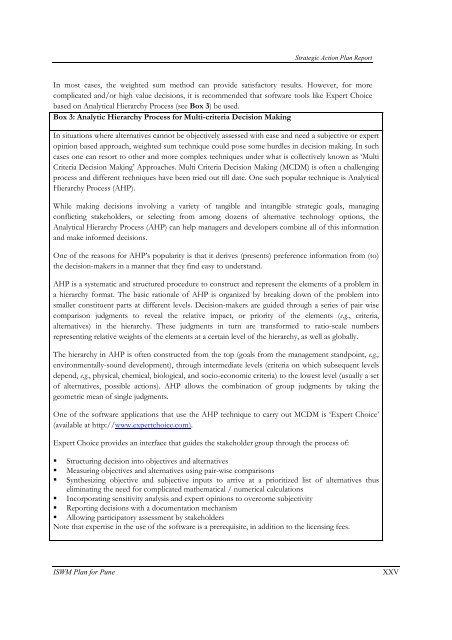Strategic Action Plan - International Environmental Technology Centre
Strategic Action Plan - International Environmental Technology Centre
Strategic Action Plan - International Environmental Technology Centre
You also want an ePaper? Increase the reach of your titles
YUMPU automatically turns print PDFs into web optimized ePapers that Google loves.
<strong>Strategic</strong> <strong>Action</strong> <strong>Plan</strong> Report<br />
In most cases, the weighted sum method can provide satisfactory results. However, for more<br />
complicated and/or high value decisions, it is recommended that software tools like Expert Choice<br />
based on Analytical Hierarchy Process (see Box 3) be used.<br />
Box 3: Analytic Hierarchy Process for Multi-criteria Decision Making<br />
In situations where alternatives cannot be objectively assessed with ease and need a subjective or expert<br />
opinion based approach, weighted sum technique could pose some hurdles in decision making. In such<br />
cases one can resort to other and more complex techniques under what is collectively known as ‘Multi<br />
Criteria Decision Making’ Approaches. Multi Criteria Decision Making (MCDM) is often a challenging<br />
process and different techniques have been tried out till date. One such popular technique is Analytical<br />
Hierarchy Process (AHP).<br />
While making decisions involving a variety of tangible and intangible strategic goals, managing<br />
conflicting stakeholders, or selecting from among dozens of alternative technology options, the<br />
Analytical Hierarchy Process (AHP) can help managers and developers combine all of this information<br />
and make informed decisions.<br />
One of the reasons for AHP’s popularity is that it derives (presents) preference information from (to)<br />
the decision-makers in a manner that they find easy to understand.<br />
AHP is a systematic and structured procedure to construct and represent the elements of a problem in<br />
a hierarchy format. The basic rationale of AHP is organized by breaking down of the problem into<br />
smaller constituent parts at different levels. Decision-makers are guided through a series of pair wise<br />
comparison judgments to reveal the relative impact, or priority of the elements (e.g., criteria,<br />
alternatives) in the hierarchy. These judgments in turn are transformed to ratio-scale numbers<br />
representing relative weights of the elements at a certain level of the hierarchy, as well as globally.<br />
The hierarchy in AHP is often constructed from the top (goals from the management standpoint, e.g.,<br />
environmentally-sound development), through intermediate levels (criteria on which subsequent levels<br />
depend, e.g., physical, chemical, biological, and socio-economic criteria) to the lowest level (usually a set<br />
of alternatives, possible actions). AHP allows the combination of group judgments by taking the<br />
geometric mean of single judgments.<br />
One of the software applications that use the AHP technique to carry out MCDM is ‘Expert Choice’<br />
(available at http://www.expertchoice.com).<br />
Expert Choice provides an interface that guides the stakeholder group through the process of:<br />
• Structuring decision into objectives and alternatives<br />
• Measuring objectives and alternatives using pair-wise comparisons<br />
• Synthesizing objective and subjective inputs to arrive at a prioritized list of alternatives thus<br />
eliminating the need for complicated mathematical / numerical calculations<br />
• Incorporating sensitivity analysis and expert opinions to overcome subjectivity<br />
• Reporting decisions with a documentation mechanism<br />
• Allowing participatory assessment by stakeholders<br />
Note that expertise in the use of the software is a prerequisite, in addition to the licensing fees.<br />
ISWM <strong>Plan</strong> for Pune<br />
XXV
















